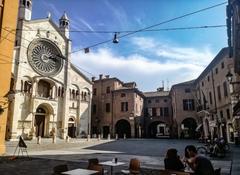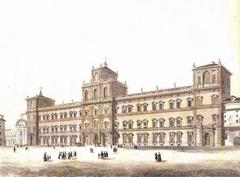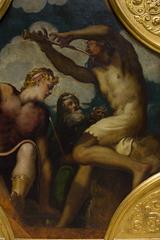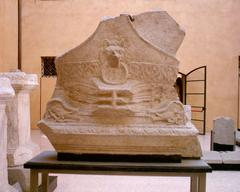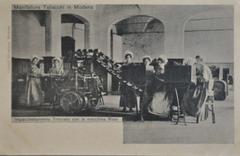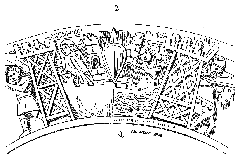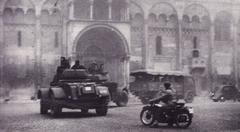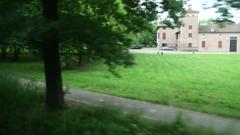Villa Buonafonte: Visiting Hours, Tickets, and Modena Historical Sites Guide
Date: 14/06/2025
Introduction
Villa Buonafonte, famously known as the “Casa dalle 100 Finestre” (House of 100 Windows), stands as a captivating testament to Modena’s aristocratic legacy, architectural distinction, and mysterious folklore. Situated near Modena, Italy, this historic villa traces its origins to the late Renaissance and Baroque periods, shaped by influential families like the Este and Bentivoglio counts. Over the centuries, Villa Buonafonte evolved from a noble summer residence to a military facility and, eventually, an enigmatic site shrouded in tales of abandonment and the paranormal. Although currently closed to the public due to preservation and safety concerns, the villa continues to fascinate historians, urban explorers, and cultural enthusiasts with its artistic features, sprawling Italianate gardens, and enduring legends.
This guide offers a comprehensive overview of Villa Buonafonte’s history, architectural and cultural importance, practical visitor information (including current access limitations), and its role within Modena’s broader heritage landscape. For travelers planning to explore Modena’s historic sites, Villa Buonafonte, despite its inaccessibility, provides an evocative glimpse into the region’s noble estates and social history (Deceuninck, International Living, Nomads Travel Guide).
Table of Contents
- Introduction
- Historical Overview
- Architectural and Artistic Features
- Cultural and Social Significance
- Visitor Information
- Travel Tips and Nearby Attractions
- Conservation and Restoration Efforts
- Frequently Asked Questions
- Conclusion
- References
Historical Overview
Origins and Early Development
Villa Buonafonte’s origins are rooted in Modena’s late Renaissance era, a time when the Este family’s influence transformed the city and countryside into a hub of culture and aristocratic living. Villas like Buonafonte were built as country retreats for nobility, blending agricultural function with leisure and social status (International Living). The villa’s initial construction aligned with Modena’s expansion along the Via Emilia, a key Roman road that facilitated growth and connectivity.
The Este Family and Modena’s Golden Age
Under Este patronage, Modena flourished as a center for the arts and sciences. Villa Buonafonte, strategically positioned outside the city center, served as both a private retreat and a venue for intellectual gatherings, reflecting the period’s values of cultural refinement and hospitality. The villa’s decorative elements, such as frescoes and landscaped gardens, were crafted by local artisans influenced by Renaissance and Baroque movements.
19th and 20th Century Transitions
The 19th century brought significant changes with the decline of the Este dynasty and Italy’s unification. Many noble estates were repurposed or fell into neglect; however, Villa Buonafonte largely maintained its character due to private ownership and adaptive uses. In the 20th century, the villa saw renewed attention for preservation as Modena modernized and recognized the importance of its architectural heritage (International Living). Restoration efforts aimed to conserve original features while adapting the estate to contemporary needs.
Architectural and Artistic Features
Villa Buonafonte exemplifies the elegance of Modena’s noble estates, with a pastel façade, grand porticoes, and original ceiling frescoes. The villa’s famed 100 windows symbolize both openness and prestige, while the Italianate gardens—with geometric layouts, ornamental fountains, and manicured hedges—offer a harmonious blend of art and nature. Interior highlights include intricate stucco work, period furnishings, and frescoes reflecting mythological and pastoral themes (International Living).
Cultural and Social Significance
Aristocratic Heritage
Constructed in the early 1700s and first documented in 1779, Villa Buonafonte was owned by the Bentivoglio counts for over 150 years (Deceuninck). As a summer residence, it embodied the nobility’s desire for rural luxury and social distinction.
Artistic and Architectural Importance
The villa’s interconnected structures showcase a blend of romantic, neoclassical, and Liberty (Art Nouveau) styles. Its interiors, featuring frescoes, tapestries, and vaulted ceilings, underscore its status as a center for cultural patronage (Deceuninck). The “100 windows” are a unique architectural hallmark symbolizing enlightenment and grandeur (Il Paranormale).
Urbex Culture & Legends
Abandoned since the 1980s, Villa Buonafonte has become a magnet for urban explorers, drawn to its haunting ambiance and decaying beauty (Cam.tv). The villa is also shrouded in legends of hauntings and occult rituals, earning nicknames like “Villa dell’Inganno” (Villa of Deceit) (Chupacabramania). These stories have become part of Modena’s contemporary folklore.
Community Perception
For Modena’s residents, Villa Buonafonte represents more than an architectural relic; it is a symbol of local heritage and collective memory. Its reputation—ranging from aristocratic grandeur to mythic haunted site—mirrors the region’s evolving cultural identity (Deceuninck).
Visitor Information
Access Limitations
As of June 2025, Villa Buonafonte is closed to the public. There are no regular visiting hours, ticket sales, or guided tours. The villa can be observed only from public roads (such as Via Vignolese). Entry onto the property is strictly prohibited and subject to legal penalties (fonteufficiale.com).
Safety and Accessibility
The villa is structurally unstable and overgrown. There are no paved paths, ramps, or visitor facilities, making it inaccessible for those with mobility challenges. Local authorities patrol the area to deter unauthorized entry.
Photography Guidelines
Photography is permitted only from public areas. Use of drones or intrusive equipment is discouraged to respect property rights and safety guidelines.
Travel Tips and Nearby Attractions
- Getting There: The villa is roughly 6–7 km southeast of Modena’s city center. Reachable by car, taxi, or buses 2A and 2B toward San Damaso. No parking or visitor drop-off is available at the villa itself.
- Nearby Attractions: Modena boasts numerous accessible sites, including Piazza Grande (UNESCO World Heritage), Modena Cathedral, Ducal Palace, Palazzo dei Musei, and the Enzo Ferrari Museum.
- Local Experiences: For immersive cultural experiences, consider guided tours of Modena’s historic center or visits to local acetaia for traditional balsamic vinegar tastings.
Conservation and Restoration Efforts
Efforts are ongoing to secure the future of Villa Buonafonte, with discussions around possible restoration and adaptive reuse as a cultural center or museum. However, as of this guide’s publication, no public opening is scheduled due to significant structural and financial challenges (Il Paranormale).
Frequently Asked Questions (FAQ)
Q: Can I visit inside Villa Buonafonte?
A: No, entry is prohibited due to safety and legal reasons.
Q: Are there official tours or events at Villa Buonafonte?
A: No regular tours or events are offered; occasionally, supervised visits may occur during heritage festivals—check local tourism resources for updates.
Q: Is the villa wheelchair accessible?
A: No, the estate is not accessible for visitors with disabilities.
Q: Can I take photographs?
A: Yes, but only from public streets nearby.
Q: Where else can I see Modena’s historic architecture?
A: Explore Piazza Grande, the Modena Cathedral, Ducal Palace, and other central city landmarks.
Conclusion
Villa Buonafonte remains an iconic yet enigmatic landmark in Modena, representing centuries of aristocratic culture, architectural splendor, and local legend. While current access is restricted, the villa endures as a source of fascination and inspiration, reflecting both the grandeur and fragility of Italy’s historic estates. Visitors to Modena are encouraged to respect the villa’s private, fragile state—observing only from public vantage points—and to explore the city’s many accessible cultural treasures. Stay informed about restoration efforts and occasional public events by following official tourism and heritage channels.
For personalized travel guides, real-time updates, and more on Modena’s attractions, download the Audiala app and consult trusted travel resources.
References
- Deceuninck, 2024, Villa Buonafonte: The Casa dalle 100 Finestre
- International Living, 2023, Modena, Italy Overview
- Nomads Travel Guide, 2024, Modena City Guide
- Il Paranormale, 2023, The Haunted Villa Buonafonte
- Modena Tourism Office, 2024, Explore Modena
- fonteufficiale.com
- Cam.tv
- Chupacabramania
- Catalogo Beni Culturali
- liveandinvestoverseas.com
- theworldwasherefirst.com
